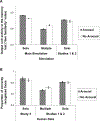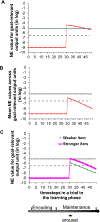Emotional arousal amplifies competitions across goal-relevant representation: A neurocomputational framework
- PMID: 30856476
- PMCID: PMC7102494
- DOI: 10.1016/j.cognition.2019.02.011
Emotional arousal amplifies competitions across goal-relevant representation: A neurocomputational framework
Abstract
Emotional arousal often facilitates memory for some aspects of an event while impairing memory for other aspects of the same event. Across three experiments, we found that emotional arousal amplifies competition among goal-relevant representations, such that arousal impairs memory for multiple goal-relevant representations while enhancing memory for solo goal-relevant information. We also present a computational model to explain the mechanisms by which emotional arousal can modulate memory in opposite ways via the local/synaptic-level noradrenergic system. The model is based on neurophysiological observations that norepinephrine (NE) released under emotional arousal is locally controlled by glutamate levels, resulting in different NE effects across regions, gating either long-term potentiation or long-term depression by activating different adrenergic receptors depending on NE concentration levels. This model successfully replicated behavioral findings from the three experiments. These findings suggest that the NE's local effects are key in determining the effects of emotion on memory.
Keywords: Emotion and memory; Neural network model; Norepinephrine; Retrograde amnesia.
Copyright © 2019 Elsevier B.V. All rights reserved.
Conflict of interest statement
The authors declare no conflict of interest.
Figures











Similar articles
-
Arousal amplifies biased competition between high and low priority memories more in women than in men: The role of elevated noradrenergic activity.Psychoneuroendocrinology. 2017 Jun;80:80-91. doi: 10.1016/j.psyneuen.2017.02.022. Epub 2017 Feb 24. Psychoneuroendocrinology. 2017. PMID: 28324703 Free PMC article.
-
Norepinephrine ignites local hotspots of neuronal excitation: How arousal amplifies selectivity in perception and memory.Behav Brain Sci. 2016 Jan;39:e200. doi: 10.1017/S0140525X15000667. Epub 2015 Jul 1. Behav Brain Sci. 2016. PMID: 26126507 Free PMC article.
-
Emotion strengthens high-priority memory traces but weakens low-priority memory traces.Psychol Sci. 2014 Feb;25(2):387-95. doi: 10.1177/0956797613504784. Epub 2013 Dec 5. Psychol Sci. 2014. PMID: 24311478 Free PMC article.
-
Noradrenergic control of emotion-induced amnesia and hypermnesia.Rev Neurosci. 2006;17(5):525-32. doi: 10.1515/revneuro.2006.17.5.525. Rev Neurosci. 2006. PMID: 17180877 Review.
-
Tuning to the significant: neural and genetic processes underlying affective enhancement of visual perception and memory.Behav Brain Res. 2014 Feb 1;259:229-41. doi: 10.1016/j.bbr.2013.11.018. Epub 2013 Nov 19. Behav Brain Res. 2014. PMID: 24269973 Review.
Cited by
-
Detection of Cognitive Load Modulation by EDA and HRV.Sensors (Basel). 2025 Apr 8;25(8):2343. doi: 10.3390/s25082343. Sensors (Basel). 2025. PMID: 40285033 Free PMC article.
-
Update on "Emotion and autobiographical memory": 14 years of advances in understanding functions, constructions, and consequences.Phys Life Rev. 2024 Dec;51:255-272. doi: 10.1016/j.plrev.2024.10.005. Epub 2024 Oct 16. Phys Life Rev. 2024. PMID: 39490139 Review.
-
Green Supply Chain Optimization Based on BP Neural Network.Front Neurorobot. 2022 May 30;16:865693. doi: 10.3389/fnbot.2022.865693. eCollection 2022. Front Neurorobot. 2022. PMID: 35711280 Free PMC article.
-
Music Emotion Analysis Based on PSO-BP Neural Network and Big Data Analysis.Comput Intell Neurosci. 2021 Sep 3;2021:6592938. doi: 10.1155/2021/6592938. eCollection 2021. Comput Intell Neurosci. 2021. Retraction in: Comput Intell Neurosci. 2023 Jun 28;2023:9789484. doi: 10.1155/2023/9789484. PMID: 34527043 Free PMC article. Retracted.
-
The effect of emotional arousal on visual attentional performance: a systematic review.Psychol Res. 2024 Feb;88(1):1-24. doi: 10.1007/s00426-023-01852-6. Epub 2023 Jul 7. Psychol Res. 2024. PMID: 37417982 Free PMC article.
References
Publication types
MeSH terms
Substances
Grants and funding
LinkOut - more resources
Full Text Sources
Medical

